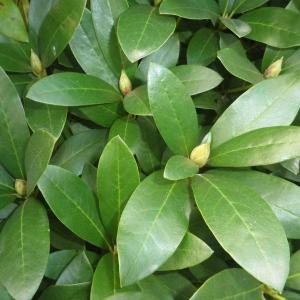A Rhododendron can reach a respectable age. In that time, branches may break off due to disease, storm, snow or building damage. This creates bare or empty spots in the Rhododendron hedge. With a growth rate of no more than 10 to 15 cm per year, natural growth takes quite a while. In many cases, the hedge is capable of restoration. By professional pruning, which makes the bare parts sprout again, and planting with younger ingrowing Rhododendrons of the same species, a visually attractive hedge is created again.

Rhododendron maintenance
all you need to know
Rhododendrons are strong and stylish ornamental shrubs which require little care. Plant them in the right way? Then you will hardly need to worry about your Rhododendrons. Only in a few cases, however, Rhododendrons do require maintenance, for instance in dry periods or when the soil does not have the right composition (any more). We will gladly explain when and how to water and fertilise your Rhododendron. We also discuss Rhododendron maintenance in case of infections and pest species.
Why does a Rhododendron need little maintenance?
The Rhododendron is native to forests. The plant thrives relatively well in acid soil and over the centuries has developed a clever system to survive in nutrient-poor places. The Rhododendron creates its own biotope. The decaying leaves of the Rhododendron form a protective insulating layer for the roots of the shrub. After a while, they are converted into nutrition for the plant. The Rhododendron is therefore basically self-sufficient and needs little maintenance.


Correct surface
Do you often have recurring problems with your Rhododendrons? Then there is a good chance that the substrate does not have the right composition. Rhododendron Center De Valouwe is specialized in realizing optimal 'floors' for Rhododendrons. We take into account, among other things, the type of Rhododendron and the soil composition of your garden. A Rhododendron needs a different 'floor' on a clay soil than on a sandy or loamy soil. With the right floor you will find that you hardly have to do Rhododendron maintenance anymore.
When should you water Rhododendrons?
Many people think of Rhododendron maintenance as watering. Rhododendrons do indeed need a relatively large amount of water, because they have large leaves. However, because the Rhododendron roots broadly and superficially, it can normally extract sufficient moisture from the soil. The soil of the Rhododendron acts like a sponge. Only in hot, dry periods is it important to look after the Rhododendron by giving it extra water.


How do you water Rhododendrons?
It is best to water Rhododendrons from below, for example by using a drip hose. This will prevent the leaves from getting wet. Wet leaves are sensitive to mould, especially in humid conditions. Would you, however, like to water the plant from above with Rhododendron maintenance, for instance with an automatic sprinkler? Do this between 5.00 and 7.00 in the morning. Then the leaves have plenty of time to dry.
How much and how often do you water Rhododendrons?
In hot, dry periods, water rhododendrons once or twice a week. When doing so, leave the drip hose on for a few hours. This is because it is better for rhododendrons to be watered a lot at once, rather than a little every day. This does not apply to rhododendrons in pots. In a pot, a lot of water evaporates from the soil. That is why potted Rhododendrons need daily watering during prolonged dry periods.


When should Rhododendrons be fertilised?
In principle, Rhododendrons do not need any fertilisers. All the nutrients that the plant needs, the Rhododendron can get from the soil. This makes the maintenance of the Rhododendron nice and easy. One condition is that the leaves of the Rhododendron should remain underneath the plant after it falls off. Fertilising Rhododendrons is only necessary in exceptional cases, such as after a wet summer. In a wet summer, too many natural nutrients may leach out, so that the Rhododendron cannot get enough nutrition from the soil. Even then, only little nutrition is needed. Usually, around 15 grams of Rhododendron fertiliser per plant is sufficient.
What feed do you use for Rhododendrons?
There are different types of fertiliser for Rhododendrons. Rhododendrons which grow on sandy soil, for example, need more magnesium. On the other hand, Rhododendrons growing in clay need fertiliser with more sulphuric acid and ammonia. Rhododendron Centre De Valouwe has Rhododendron fertilizer for all types of soil. We will be happy to advise you on which type of fertiliser is suitable for maintaining your Rhododendrons.


When should the Rhododendron be pruned?
In principle, it is not necessary to prune your Rhododendrons. The Rhododendron will regenerate itself every year. Do you want to shape your Rhododendron in a specific way or keep it in a certain size? Then pruning is necessary. It is best to do this just after the flowering period. More information on pruning Rhododendrons can be found on our knowledge page on pruning Rhododendrons.
Removing flowers from the Rhododendron
After the flowering period, you can remove the dead flowers from the Rhododendron. This is done by grasping the bud between your thumb and forefinger. Then gently break off the bud. By removing the dead flowers, the Rhododendron will put even more energy into forming new shoots and will grow beautifully again next year.


Ask your questions about Rhododendron maintenance
Ask your questions about Rhododendron maintenance
Do you have questions about Rhododendron maintenance? Or specific questions about a problem with the Rhododendrons in your garden? Rhododendron Center De Valouwe is happy to help you. Ask your question without obligation to one of our Rhododendron specialists. It helps if you send photos of your Rhododendron by mail or app. This way we can advise you on the right way of Rhododendron maintenance.



